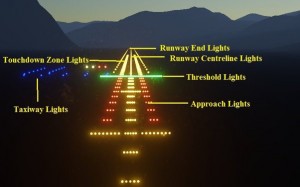March 12, 2024
Artificial Intelligence (AI), embedded systems, Fifth Industrial Revolution, Industry 5.0, Internet of Things, IoT, IoT Devices, Smart City, Software, Technology
No comments
Lighting the Way: A Closer Look at Airfield Ground Lighting in Airports
Air travel is amazing, right? But have you ever thought about what helps planes take off and land safely? That’s where Airfield Ground Lighting (AGL) Management Systems come in. These systems are like silent heroes, making sure flights are safe and smooth. Let’s explore the world of AGL systems and discover how they work.
- Components of AGL Systems: A) Runway Lighting- These lights on the runway help pilots take off and land by showing the edges, starting point, and endpoint. B) Taxiway Lighting- Like road signs for planes, these lights guide aircraft along taxiways with centerline lights, signal stops with stop bar lights, and indicate when to cross with clearance bar lights. C) Approach Lighting Systems- These lights assist pilots when landing, making the final approach clear and visible. D) Apron Lighting- Lights on the apron help pilots park their planes and move safely on the ground.
- Technology: A) LED Technology- Lights now use LEDs, which last a long time, save energy, and help pilots see better. B) Control Systems- Smart systems control all the lights from one place, making sure they work together for safe airplane movements. C) Automation- Lights can change on their own based on things like weather or how many planes are around. This helps keep everything running smoothly.
- Design and Installation: A) Regulatory Compliance- AGL systems must adhere to international aviation regulations, such as those set by ICAO and National Aviation Authorities. B) Factors Influencing Design- Airport size, traffic volume, environmental conditions, and geographic considerations impact the design of AGL systems. C) Installation Best Practices- Collaboration with electrical engineers, rigorous testing, and quality assurance are critical during installation.
- Maintenance and Monitoring: A) Routine Inspections- Regular checks for damaged lights, malfunctioning components, and cleanliness to maintain optimal visibility. B) Monitoring Systems- Advanced monitoring tools enable real-time analysis, helping identify issues for timely maintenance. C) Predictive Maintenance- Utilizing data to predict and address potential problems before they Impact operations.
- Challenges and Solutions: A) Weather-Related Challenges- AGL systems need to function effectively in various weather conditions, including fog, snow, and rain. High-intensity lighting and other technologies address these challenges. B) Cybersecurity Concerns- With increasing connectivity, securing AGL systems against cyber threats is crucial. Implementing secure communication protocols is vital.
- Future Trends: A) Integration with Smart Airports- AGL systems are becoming more integrated with overall airport management systems, contributing to the concept of smart airports. B) Sustainable Solutions- The industry is moving towards sustainable practices, including solar-powered AGL systems and energy-efficient technologies. C) Advanced Technologies- The incorporation of artificial intelligence (AI) and the Internet of Things (IoT) for data-driven decision-making and enhanced operational efficiency.
Effective management of AGL systems is paramount for the safe and smooth functioning of airports. Technological advancements, regulatory compliance, and proactive maintenance contribute to the reliability and resilience of these critical systems in Aviation.
Author- Moumita Ghosh










Leave a Reply